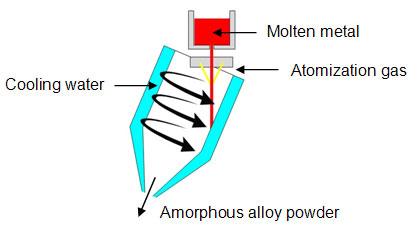Seiko Epson Corporation (TSE: 6724, “Epson”) makes everything from watch movements to desktop printers. Given its precision and printing expertise it has long been speculated that the company would enter the 3D printing market. It did so last month, with an industrial extrusion system. Now it has, it is moving further into the space. Epson subsidiary Atmix, which makes artificial quartz and metal injection molding (MIM) parts, will produce powder for MIM and 3D printing.
Atmix is building a factory to manufacture its own powder, recycling Epson metals and the scrap of its partners. The logic behind this is not only commercial but based on the desire of Epson Group to be “underground resource free by 2050.” Epson suggests that it will not mine for any virgin nonrenewable materials by that time. This is seen as an environmentally advantageous move that also reduces the risk of the group to higher prices in the future.
The plant will take in metal powder products that are out of spec, as well as waste from its factory, used molds, dies, and metal scrap from Epson and its partners. Within three years of the factory’s operations, the company expects recycled metal to represent 25 percent of the total raw metal needs of Atmix.
To produce the powders, the company uses water atomization and a unique Spinning Water Atomization Process (SWAP) that can make amorphous metals and amorphous magnetic powders. With SWAP, a molten metal is broken up with high pressure gas and then quickly cooled.

On the polymer side, Epson is creating new IP by fundamentally improving extrusion processes. By coordinating extrusion speed through a valve and depositing material at a controlled temperature and in a highly precise way, the company aims for better layer adhesion and part strength. By making it open to a broad portfolio of materials, this technology could be of use in many areas while maintaining a low cost.

It seems that Epson is inching its way towards the 3D printer market. It is not only releasing a machine but also a powder that could see broader adoption. The firm is deploying 3D printing in a cost-conscious way. Epson’s 3D printer launch was not flashy and not supported by a lot of collateral or marketing heft. The company has not made any huge investments in additive. It is also creating a relatively simple 3D printer.
On the powder side, the company is looking at its metal footprint and materials to guide it. It is looking to replace its own virgin materials use most of all. Now, considering the size of Epson as a company and all of its watches and cartridges, the firm has a long way to go. After all, it has over $9 billion in revenue and 67,000 employees.

However, by only covering its own needs, it can become a player in our comparatively tiny market. The 3D printer seems likely to be able to process pellets of many sizes and grades, so as to take on a large selection of known plastic waste materials. Metal waste could be atomized, which would use a lot of energy but would let it be made into accurate MIM parts or 3D printed parts. It’s a very logical approach for the firm.
It would also make sense for the company to release a binder jet machine for production runs lower than can be fulfilled with MIM. Taken together this could be a rather well-defined and -executed recycling strategy for a large company’s metals into new products. I’m not sure how many other firms will look to developing new technologies in tandem with additive to turn to more efficient use and reuse of their materials. Let’s hope that there will be many more.
Subscribe to Our Email Newsletter
Stay up-to-date on all the latest news from the 3D printing industry and receive information and offers from third party vendors.
Print Services
Upload your 3D Models and get them printed quickly and efficiently.
You May Also Like
U.S. Navy Lab Uses 3D Printing to Reduce Tooling Lead Time By Over 90%
The F-35 Lightning II Joint Program Office (JPO), responsible for life-cycle management of the key fifth-generation joint strike fighter (JSF) system used by the U.S., its allies, and its partners,...
Etsy Design Rule Change Reduces Selection of 3D Printed Goods
Online marketplace Etsy has implemented a rule change requiring all 3D printed goods on the site to be original designs. The update to the site’s Creativity Standards states, ¨Items produced using...
Honeywell Qualifies 6K Additive’s Nickel 718 for 3D Printed Aerospace & Defense Parts
6K Additive is renowned for manufacturing sustainable additive manufacturing (AM) powder, and offers a wide portfolio of premium metal and alloy powders that include titanium, copper, stainless steel, and nickel,...
MetalWorm Sells WAAM Systems to Research Institutes in Brazil and Malaysia
Turkish WAAM firm MetalWorm has sold a system in Malaysia and another in Brazil. This is an excellent example of a few emerging trends in additive. Firstly, WAAM was experimented...

































